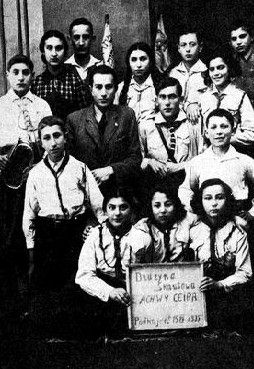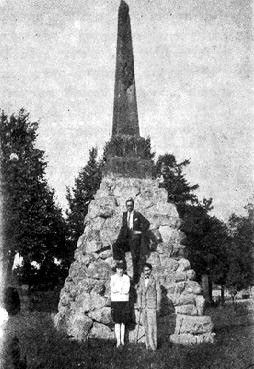 |
 |
against the Turks under the leadership
of Jan Sowiecki in the year 1667
|
The revolution of 1848, which brought changes to the internal statesmanship of the Hapsburg Monarchy, awakened many hopes within the Jews of Galicia as well. They believed that a good and firm future awaited them from all perspectives.
Their interest was at first toward the repeal of the two taxes that were difficult and despised by them – the kosher meat tax and candle tax. Indeed, after a period of unclearness and various rumors regarding the repeal of these taxes, the parliament decided on October 5th, 1848 to repeal all of the taxes upon the Jews. Similarly, the Jews were declared to be equal citizens with regard to all rights and duties that were upon the rest of the residents of the land.
In the first census that took place in Podhajce in the year 1765, 1,548 people were enumerated in the entire community, and 1,290 in Podhajce itself. Starting from 1870, a census took place every ten years. We have access to a detailed table of the number of Jews in the city, and their percentage with respect to the general population.
| Year | General population | Number of Jews | % |
| 1870 | 4,570 | 2,742 | 60.0 |
| 1880 | 5,943 | 4,012 | 67.5 |
| 1890 | 5,646 | 3,879 | 68.7 |
| 1900 | 5,790 | 3,757 | 64.9 |
| 1910 | 5,576 | 3,497 | 62.7 |
| 1921 | 4,814 | 2,872 | 59.7 |
| 1931 | 5,743 | 3,124 | 54.4 |
| 1939 | 6,000 | 3,155 | 53.0 |
We do not have detailed information about the sources of livelihood of the Jews of Podhajce. There exists an accounting of the business and work departments in Brody from 1876-1881 which details the number of those working in the various branches of business and labor, without a breakdown by nationality[51]. According to this accounting, there were 1,281 craftsmen and workers in the city and region, and 350 who worked in business. It would appear that, similar to other cities, almost all of the merchants and a large portion of the craftsmen in Podhajce were members of the Jewish community.
Starting from the beginning of the 20th century, decisive changes took place in the professional makeup of the Jewish population. Many young people completed their courses of study in high schools and became lawyers, doctors and engineers. However, due to the special relationship of the Polish authorities with the Jews, many remained without employment.
The Jews of Podhajce were among the first to whom the nationalist idea came. In one of the Hebrew newspapers from 1876, a writer describes Podhajce as being dissimilar from neighboring towns “that live in darkness and are hidden from the light of the world”, so that a new light will not penetrate its rays to them. However, it follows in the footsteps of the large cities, and warms itself toward ideas that offer a solution to life in the Diaspora. In Tishrei 5636 (1877), a group was founded in Podhajce that had the purpose of “reading timely letters in the holy language and in the language of the land”.
[Page 43]
|
|
|||
| Members of the “Achva Tzeira in 1935 | A monument in memory of the war against the Turks under the leadership of Jan Sowiecki in the year 1667 |
|
|
A group of youths who were members of “Hanoar Hatzioni” (1930) |
[Page 44]
The members gathered daily in a premises that they rented, and discussed the mysteries of the times. The organization selected for itself the name “Meeting Place of Jewish Citizens” (Izraeliteshes Birgerliches Kasino)[52].
At the time of the beginning of the emigration of Russian Jews to outside lands, voices were heard in Galicia demanding that the stream of refugees be directed to the Land of Israel rather than America. It is interesting that the Viennese “Alians” branch in Podhajce, which was headed by the Maskilim Yehuda Leibush Alerhand and Shaul Schorr, collected money for the benefit of the refugees of Russia, and sent it to Vienna with the condition “That the money that is sent by the help organization (Alians) only go to those who are going to Palestine, and not to the exiles in America.[53].
On the other hand, the anti-Semitic movements, which sprouted in Galicia in those days and were modeled after such movements in Germany and Vienna, also influenced the situation of the Jews. The matter of Jewish lessees of land in Podhajce was of particular influence. In the year 1891, two assimilated Jews leased lands in Podhajce from a certain insurance company in Krakow. This matter angered the Polish noblemen, who demanded that the travesty be rectified, and that the contract issued to the Jews be nullified, since they were strangers in Poland. The leasing of lands to Jews was regarded as a unpatriotic and anti-nationalist deed. The Polish noblemen in the regions of Podhajce and Kolomya gathered even together in a convention and strongly protested the deeds of the group. This matter caused a strong anti-Semitic outbreak in the Polish newspapers, and angered the spirit of the Jewish intelligentsia. Influenced by this situation, most of the members of the committee of the “Agudat Achim” decided to abandon the assimilationist idea and to concentrate their educational activities only among the Jews[54].
The “Ahavat Tzion” organization, that was founded in Vienna by Peretz Smolneskin and Dr. Reuven Birer in the year 1884, was accepted with great admiration among the Jewish community. It decided to establish a settlement in the Land of Israel for Jewish farmers from Galicia. Immediately after the founding of Ahavat Tzion, Dr. A. Zaltz began to concern himself with purchasing a tract of land for the Galician settlement. He was invited by Baron Edmond Rothschild to come to Paris, and on September 7th, 1897, a contract was signed between him and the representatives of the Baron stating that Ahavat Tzion purchased an 8,600 dunam tract of land in the Galilee for 50 families. Dr. Zaltz decided to call the moshava Machanaim. This was the Arab village of Kibaa that was found between the Rosh Pina moshava and Mishmei Hayarden. The news of the purchase was received with great joy in Galicia. Elyakim Getzel Perel of Podhajce, age 30, was among the group of 11 settlers who were sent to Machanaim in November, 1898[55].
With the spreading of the Chibat Tzion movement and the development of Zionism, the revival of the Hebrew language also took place. Various organizations were founded for the speaking and nurturing of the Hebrew language among those who had set their eyes upon Zion. The Hebrew newspaper Hamagid that appeared in the Prussian city of Lyck made its way to various areas among the cities of Galicia. Its absolutist recommendations aroused anger in the Zionist circles, and there were those that advised banning Hamagid and supporting the Zionist newspapers of Galicia. There were a few writers in Podhajce who published essays on Jewish life in the city and the events therein. Thus, readers in other cities were able to obtain some idea about the Jews of Podhajce. They started in Hamagid and continued on with articles in other newspapers. Hamitzpeh, which was published in Krakow under the editorship of Shimon Menachem Lazar, published articles from time to time by people who concealed their identities with pseudonyms. Similar articles were published in Polish, German and Yiddish publications. Even the Machzikei Hadas newspaper of Agudas Yisroel did not neglect to mention Podhajce[56].
The First World War, the invasion of the Russian armies into Eastern Galicia in August 1914, and the events of the war that did not skip over any settlement in Galicia, left their mark upon the community and the Jewish population, who for the most part escaped westward. The activities of the community and its institutions ceased. Civic life, including Jewish life, only resumed their normal course at the end of the First World War in 1918. The community began to operate in a normal manner, and acted to the best of its abilities until June 1919. At that point, the Polish army conquered the city, and the Polish authorities opened their offices. The era of Polish rule in the life of the community of Podhajce began.
|
JewishGen, Inc. makes no representations regarding the accuracy of
the translation. The reader may wish to refer to the original material
for verification.
JewishGen is not responsible for inaccuracies or omissions in the original work and cannot rewrite or edit the text to correct inaccuracies and/or omissions.
Our mission is to produce a translation of the original work and we cannot verify the accuracy of statements or alter facts cited.
 Podgaytsy, Ukraine
Podgaytsy, Ukraine
 Yizkor Book Project
Yizkor Book Project
 JewishGen Home Page
JewishGen Home Page
Copyright © 1999-2024 by JewishGen, Inc.
Updated 20 Oct 2005 by LA